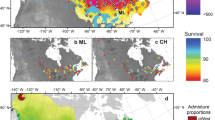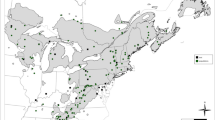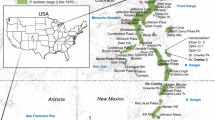Abstract
Given increasing forest disturbances, novel solutions are needed to rapidly recover ecosystem services such as carbon storage, while bolstering climate change adaptation. Reforestation with single-species mixed-provenance plantings is an emerging strategy that may enhance stand productivity and disturbance resistance, while assisted gene flow is a potentially powerful tool for matching seed-source with future planting-site climate. We investigated the potential of mixed-provenance plantings and assisted gene flow for maximizing early growth using a historical dataset for knobcone-Monterey pine (Pinus x attenuradiata), a fire-resilient hybrid developed for low-elevation sites in California, USA. We examined (1) 9-year individual-tree relative growth rate (RGR) in response to neighborhood seed-parent provenance diversity at two test sites and (2) 3-year RGR and survival as functions of parent seed-source climate at 4 test sites. We found 9-year RGR varied with seed provenance diversity, with 3 of 5 provenances showing a positive RGR-diversity relationship. Parent seed-source climate affected 3-year RGR but not survival. Closer climate matches in terms of precipitation as snow (PAS) showed fastest growth. Our results suggest careful selection and arrangement of genetically diverse stock may improve carbon sequestration and initial planting success in a hybrid conifer, with implications for reforestation under climate change and reburn risk.



Similar content being viewed by others
Data Availability
The datasets used in this study are available in the USDA Forest Service Research Data Archives, https://www.fs.usda.gov/rds/archive/catalog/RDS-2023-0038.
References
Aakala T, Fraver S, D’Amato AW, Palik BJ (2013) Influence of competition and age on tree growth in structurally complex old-growth forests in northern Minnesota, USA. For Ecol Manag 308:128–135. https://doi.org/10.1016/j.foreco.2013.07.057
Akaike H (1974) A new look at the statistical model identification. IEEE Trans Autom Control 19:716–723. https://doi.org/10.1109/TAC.1974.1100705
Aspinwall MJ, King JS, McKeand SE, Bullock BP (2011) Genetic effects on stand-level uniformity and above- and belowground dry mass production in juvenile loblolly pine. For Ecol Manag 262:609–619. https://doi.org/10.1016/j.foreco.2011.04.029
Bansal S, Harrington CA, St. Clair JB (2016) Tolerance to multiple climate stressors: a case study of Douglas-fir drought and cold hardiness. Ecol Evol 6:2074–2083. https://doi.org/10.1002/ece3.2007
Bartoń K (2017) MuMln: Multi-model inference
Bourdier T, Cordonnier T, Kunstler G et al (2016) PLoS ONE 11:e0151852. https://doi.org/10.1371/journal.pone.0151852. Tree Size Inequality Reduces Forest Productivity: An Analysis Combining Inventory Data for Ten European Species and a Light Competition Model
Boyden S, Binkley D, Stape JL (2008) Competition among Eucalyptus Trees depends on genetic variation and resource supply. Ecology 89:2850–2859. https://doi.org/10.1890/07-1733.1
Buotte PC, Levis S, Law BE et al (2019) Near-future forest vulnerability to drought and fire varies across the western United States. Glob Change Biol 25:290–303. https://doi.org/10.1111/gcb.14490
Burnham KP, Anderson DR (2002) Model selection and Multimodel Inference: a practical information-theoretic Approach, 2nd edn. Springer-Verlag, New York
Davis KT, Dobrowski SZ, Higuera PE et al (2019) Wildfires and climate change push low-elevation forests across a critical climate threshold for tree regeneration. Proc Natl Acad Sci 116:6193–6198. https://doi.org/10.1073/pnas.1815107116
Eck JL, Stump SM, Delavaux CS et al (2019) Evidence of within-species specialization by soil microbes and the implications for plant community diversity. Proc Natl Acad Sci 116:7371–7376. https://doi.org/10.1073/pnas.1810767116
ESRI inc (2021) ArcGIS Pro [GIS software] Version 2.8. Environmental Systems Research Institute, Redlands, CA.
Fischer DG, Wimp GM, Hersch-Green E et al (2017) Tree genetics strongly affect forest productivity, but intraspecific diversity–productivity relationships do not. Funct Ecol 31:520–529. https://doi.org/10.1111/1365-2435.12733
Forrester DI, Bauhus J (2016) A review of processes behind diversity-productivity relationships in forests. Curr For Rep 2:45–61. https://doi.org/10.1007/s40725-016-0031-2
Forrester DI, Bauhus J, Khanna PK (2004) Growth dynamics in a mixed-species plantation of Eucalyptus globulus and Acacia mearnsii. For Ecol Manag 193:81–95. https://doi.org/10.1016/j.foreco.2004.01.024
Gómez-Aparicio L, García-Valdés R, Ruíz-Benito P, Zavala MA (2011) Disentangling the relative importance of climate, size and competition on tree growth in Iberian forests: implications for forest management under global change. Glob Change Biol 17:2400–2414. https://doi.org/10.1111/j.1365-2486.2011.02421.x
Gould PJ, Bradley St, Clair J, Anderson PD (2011) Performance of full-sib families of Douglas-fir in pure-family and mixed-family deployments. For Ecol Manag 262:1417–1425. https://doi.org/10.1016/j.foreco.2011.06.042
Grady KC, Kolb TE, Ikeda DH, Whitham TG (2015) A bridge too far: cold and pathogen constraints to assisted migration of riparian forests. Restor Ecol 23:811–820. https://doi.org/10.1111/rec.12245
Griffin JR, Conkle MT (1967) Early performance of knobcone x monterey pine hybrids… on marginal timber sites. Res note PSW-RN-156 Berkeley CA US Dep Agric for Serv Pac Southwest for Range Exp Stn 10 P
Hegyi F (1974) A simulation model for managing jack-pine stands. Growth Models Tree Stand Simul 74–90
Hunt R, Cornelissen JHC (1997) Components of relative growth rate and their interrelations in 59 temperate plant species. New Phytol 135:395–417. https://doi.org/10.1046/j.1469-8137.1997.00671.x
Ishii H, Asano S (2010) The role of crown architecture, leaf phenology and photosynthetic activity in promoting complementary use of light among coexisting species in temperate forests. Ecol Res 25:715–722. https://doi.org/10.1007/s11284-009-0668-4
James G, Witten D, Hastie T, Tibshirani R (2021) An introduction to statistical learning: with applications in R, 2nd edn. Springer US
Johnston JD, Dunn CJ, Vernon MJ (2019) Tree traits influence response to fire severity in the western Oregon Cascades, USA. For Ecol Manag 433:690–698. https://doi.org/10.1016/j.foreco.2018.11.047
Jucker T, Bouriaud O, Avacaritei D et al (2014) Competition for light and water play contrasting roles in driving diversity–productivity relationships in Iberian forests. J Ecol 102:1202–1213. https://doi.org/10.1111/1365-2745.12276
Jucker T, Bouriaud O, Coomes DA (2015) Crown plasticity enables trees to optimize canopy packing in mixed-species forests. Funct Ecol 29:1078–1086. https://doi.org/10.1111/1365-2435.12428
Jucker T, Avăcăriței D, Bărnoaiea I et al (2016) Climate modulates the effects of tree diversity on forest productivity. J Ecol 104:388–398. https://doi.org/10.1111/1365-2745.12522
Jucker T, Koricheva J, Finér L et al (2020) Good things take time—diversity effects on tree growth shift from negative to positive during stand development in boreal forests. J Ecol 108:2198–2211
Klos PZ, Link TE, Abatzoglou JT (2014) Extent of the rain-snow transition zone in the western U.S. under historic and projected climate. Geophys Res Lett 41:4560–4568. https://doi.org/10.1002/2014GL060500
Koontz MJ, Latimer AM, Mortenson LA et al (2021) Cross-scale interaction of host tree size and climatic water deficit governs bark beetle-induced tree mortality. Nat Commun 12. https://doi.org/10.1038/s41467-020-20455-y
Lanner RM (1985) On the insensitivity of height growth to spacing. For Ecol Manag 13:143–148. https://doi.org/10.1016/0378-1127(85)90030-1
Liu Y, He F (2021) Warming intensifies soil pathogen negative feedback on a temperate tree. New Phytol 231:2297–2307. https://doi.org/10.1111/nph.17409
Lutz JA, van Wagtendonk JW, Franklin JF (2010) Climatic water deficit, tree species ranges, and climate change in Yosemite National Park. J Biogeogr 37:936–950. https://doi.org/10.1111/j.1365-2699.2009.02268.x
Luu TC, Binkley D, Stape JL (2013) Neighborhood uniformity increases growth of individual Eucalyptus trees. For Ecol Manag 289:90–97. https://doi.org/10.1016/j.foreco.2012.09.033
Malmsheimer RW, Heffernan P, Brink S et al (2009) Forest management solutions for mitigating climate change in the United States. Society of American Foresters
McDonald PM, Fiddler GO (2010) Twenty-five years of managing vegetation in conifer plantations in northern and central California: results, application, principles, and challenges. Gen Tech Rep PSW-GTR-231. https://doi.org/10.2737/PSW-GTR-231. Albany CA US Dep Agric For Serv Pac Southwest Res Stn
Mead DJ (2013) Sustainable management of Pinus radiata plantations. Food and Agriculture Organization of the United Nations, Rome, Italy
Mina M, Huber MO, Forrester DI et al (2018) Multiple factors modulate tree growth complementarity in central european mixed forests. J Ecol 106:1106–1119. https://doi.org/10.1111/1365-2745.12846
Moran GF, Bell JC, Eldridge KG (1988) The genetic structure and the conservation of the five natural populations of Pinusradiata. Can J For Res 18:506–514. https://doi.org/10.1139/x88-074
Nykänen M-L, Peltola H, Quine C et al (1997) Factors affecting snow damage of trees with particular reference to european conditions
O’Neill GA, Stoehr M, Jaquish B (2014) Quantifying safe seed transfer distance and impacts of tree breeding on adaptation. For Ecol Manag 328:122–130. https://doi.org/10.1016/j.foreco.2014.05.039
Oliver WW (1979) Growth and mortality of thinned knobcone x Monterey pine saplings affected by engraver beetles and a hard freeze. U.S. Dept. of Agriculture, Forest Service, Pacific Southwest Research Station
Ouzts J, Kolb T, Huffman D, Sánchez Meador A (2015) Post-fire ponderosa pine regeneration with and without planting in Arizona and New Mexico. For Ecol Manag 354:281–290. https://doi.org/10.1016/j.foreco.2015.06.001
Pedlar JH, McKenney DW, Lu P (2021) Critical seed transfer distances for selected tree species in Eastern North America. J Ecol 109:2271–2283. https://doi.org/10.1111/1365-2745.13605
Pinheiro JC, Bates DM (eds) (2000) Mixed-Effects Models in S and S-PLUS. Springer New York, New York, NY, pp 133–199. Fitting Linear Mixed-Effects Models
Pommerening A, Maleki K, Haufe J (2021) Tamm Review: individual-based forest management or seeing the trees for the forest. For Ecol Manag 501:119677. https://doi.org/10.1016/j.foreco.2021.119677
Powers RF, Reynolds PE (2011) Ten-year responses of ponderosa pine plantations to repeated vegetation and nutrient control along an environmental gradient. Can J For Res. https://doi.org/10.1139/x99-104
Pretzsch H (2005) Diversity and productivity in forests: evidence from long-term experimental plots. In: Scherer-Lorenzen M, Körner C, Schulze ED (eds) Forest diversity and function. Springer, Verlag, Berlin-Heidelberg, p 401
Pretzsch H (2021) Genetic diversity reduces competition and increases tree growth on a Norway spruce (Picea abies [L.] Karst.) Provenance mixing experiment. For Ecol Manag 497:119498. https://doi.org/10.1016/j.foreco.2021.119498
Pretzsch H, Biber P (2016) Tree species mixing can increase maximum stand density. Can J For Res 46:1179–1193. https://doi.org/10.1139/cjfr-2015-0413
Rehfeldt GE, Ying CC, Spittlehouse DL, Hamilton Jr DA (1999) Genetic responses to climate in pinus contorta: niche breadth, climate change, and reforestation. Ecol Monogr 69:375–407. https://doi.org/10.1890/0012-9615(1999)069[0375:GRTCIP]2.0.CO;2
Richards SA (2008) Dealing with overdispersed count data in applied ecology. J Appl Ecol 45:218–227. https://doi.org/10.1111/j.1365-2664.2007.01377.x
Rodríguez-Trejo DA, Fulé PZ (2003) Fire ecology of mexican pines and a fire management proposal. Int J Wildland Fire 12:23–37. https://doi.org/10.1071/WF02040
Rweyongeza DM, Dhir NK, Barnhardt LK et al (2007) Population differentiation of the lodgepole pine (Pinus contorta) and jack pine (Pinus banksiana) complex in Alberta: growth, survival, and responses to climate. Can J Bot 85:545–556. https://doi.org/10.1139/B07-053
Shive KL, Preisler HK, Welch KR et al (2018) From the stand scale to the landscape scale: predicting the spatial patterns of forest regeneration after disturbance. Ecol Appl 28:1626–1639. https://doi.org/10.1002/eap.1756
St. Clair JB, Howe GT, Kling JG (2020) The 1912 Douglas-Fir Heredity Study: Long-Term Effects of climatic transfer Distance on Growth and Survival. J For 118:1–13. https://doi.org/10.1093/jofore/fvz064
St. Clair JB, Richardson BA, Stevenson-Molnar N et al (2022) Seedlot Selection Tool and Climate-Smart Restoration Tool: web-based tools for sourcing seed adapted to future climates. Ecosphere 13:e4089. https://doi.org/10.1002/ecs2.4089
Stevens-Rumann CS, Kemp KB, Higuera PE et al (2018) Evidence for declining forest resilience to wildfires under climate change. Ecol Lett 21:243–252. https://doi.org/10.1111/ele.12889
Stewart JAE, van Mantgem PJ, Young DJN et al (2021) Effects of postfire climate and seed availability on postfire conifer regeneration. Ecol Appl 31:e02280. https://doi.org/10.1002/eap.2280
Tepley AJ, Thompson JR, Epstein HE, Anderson-Teixeira KJ (2017) Vulnerability to forest loss through altered postfire recovery dynamics in a warming climate in the Klamath Mountains. Glob Change Biol 23:4117–4132. https://doi.org/10.1111/gcb.13704
Toïgo M, Vallet P, Perot T et al (2015) Overyielding in mixed forests decreases with site productivity. J Ecol 103:502–512. https://doi.org/10.1111/1365-2745.12353
Ukrainetz NK, O’Neill GA, Jaquish B (2011) Comparison of fixed and focal point seed transfer systems for reforestation and assisted migration: a case study for interior spruce in British Columbia. Can J For Res 41:1452–1464. https://doi.org/10.1139/x11-060
Wang T, Hamann A, Spittlehouse D, Carroll C (2016) Locally downscaled and spatially customizable climate data for historical and future periods for North America. PLoS ONE 11:e0156720. https://doi.org/10.1371/journal.pone.0156720
Williams LJ, Paquette A, Cavender-Bares J et al (2017) Spatial complementarity in tree crowns explains overyielding in species mixtures. Nat Ecol Evol 1:1–7. https://doi.org/10.1038/s41559-016-0063
Wright JW (2007) Local adaptation to serpentine soils in Pinus ponderosa. Plant Soil 293:209–217. https://doi.org/10.1007/s11104-006-9181-5
Yachi S, Loreau M (1999) Biodiversity and ecosystem productivity in a fluctuating environment: the insurance hypothesis. Proc Natl Acad Sci 96:1463. https://doi.org/10.1073/pnas.96.4.1463
Yao Y, Vehtari A, Simpson D, Gelman A (2018) Using stacking to average bayesian predictive distributions (with discussion). Bayesian Anal 13:917–1007. https://doi.org/10.1214/17-BA1091
York RA, Noble H, Quinn-Davidson LN, Battles JJ (2021) Pyrosilviculture: combining prescribed fire with gap-based silviculture in mixed-conifer forests of the Sierra Nevada. Can J For Res 51:781–791. https://doi.org/10.1139/cjfr-2020-0337
Zhai L, Jokela EJ, Gezan SA, Vogel JG (2015) Family, environment and silviculture effects in pure- and mixed-family stands of loblolly (Pinus taeda L.) and slash (P. elliottii Engelm. Var. Elliotttii) pine. For Ecol Manag 337:28–40. https://doi.org/10.1016/j.foreco.2014.10.030
Zhang J, Webster J, Powers RF, Mills J (2008) Reforestation after the Fountain Fire in Northern California: an untold Success Story. J For 106:425–430. https://doi.org/10.1093/jof/106.8.425
Zhang J, Finley KA, Young DH et al (2022) Growth response of ponderosa pine to intensive cultural treatments varies with site quality and plantation age. For Sci 68
Zimová S, Dobor L, Hlásny T et al (2020) Reducing rotation age to address increasing disturbances in Central Europe: potential and limitations. For Ecol Manag 475:118408. https://doi.org/10.1016/j.foreco.2020.118408
Zuur A, Ieno EN, Walker N et al (2009) Mixed Effects models and extensions in Ecology with R. Springer Science & Business Media
Acknowledgements
We thank Carol Shestak for assistance with field resurveys, locating establishment and progress reports, and archiving stem maps. Erin Estrada digitized field data and notes. Bob Carlson helped with additional field work. The BLM Redding Field Office reviewed and approved resurvey work. Nels Johnson provided code for modeling spatial autocorrelation across disjunct test sites. Kevin Martin provided a thorough literature search on KMX pine. Jessica Wright helped locate parent-tree records at the Institute of Forest Genetics and consulted on serpentine soil effects. This study would not have been possible but for the careful study planning, establishment, field data collection, reporting, and record keeping by the original PI, James Griffin, and co-PI, M. Thompson Conkle. Bill Sundahl, Bill Oliver, Bob Powers, Phil McDonald, R. Rappley, and unnamed members of BLM crews helped collect the original field data and maintain the study. Martin Ritchie, Jianwei Zhang, and Bill Oliver provided encouragement and help with relocating field sites. Finally, we thank the associate editor and anonymous reviewer, whose comments greatly improved the final version of this article.
Funding
Funding for this study was provided by the USDA Forest Service Pacific Southwest Research Station, which also supported the development and past experimental studies of the KMX hybrid from which the dataset for this paper was derived.
Author information
Authors and Affiliations
Contributions
Christopher Looney conceived the study, and all authors contributed to the study design. Christopher Looney and Katherine Wood performed data collection and preparation. Christopher Looney and Joseph Stewart performed data analysis. Christopher Looney wrote the first draft of the manuscript. All authors commented on subsequent versions and read and approved the final version.
Corresponding author
Ethics declarations
Competing interests
The authors declare no conflict of interest.
Additional information
Publisher’s Note
Springer Nature remains neutral with regard to jurisdictional claims in published maps and institutional affiliations.
Electronic supplementary material
Below is the link to the electronic supplementary material.
Rights and permissions
Springer Nature or its licensor (e.g. a society or other partner) holds exclusive rights to this article under a publishing agreement with the author(s) or other rightsholder(s); author self-archiving of the accepted manuscript version of this article is solely governed by the terms of such publishing agreement and applicable law.
About this article
Cite this article
Looney, C.E., Stewart, J.A. & Wood, K.E. Mixed-provenance plantings and climatic transfer-distance affect the early growth of knobcone-monterey hybrid pine, a fire-resilient alternative for reforestation. New Forests 55, 543–565 (2024). https://doi.org/10.1007/s11056-023-09991-9
Received:
Accepted:
Published:
Issue Date:
DOI: https://doi.org/10.1007/s11056-023-09991-9




